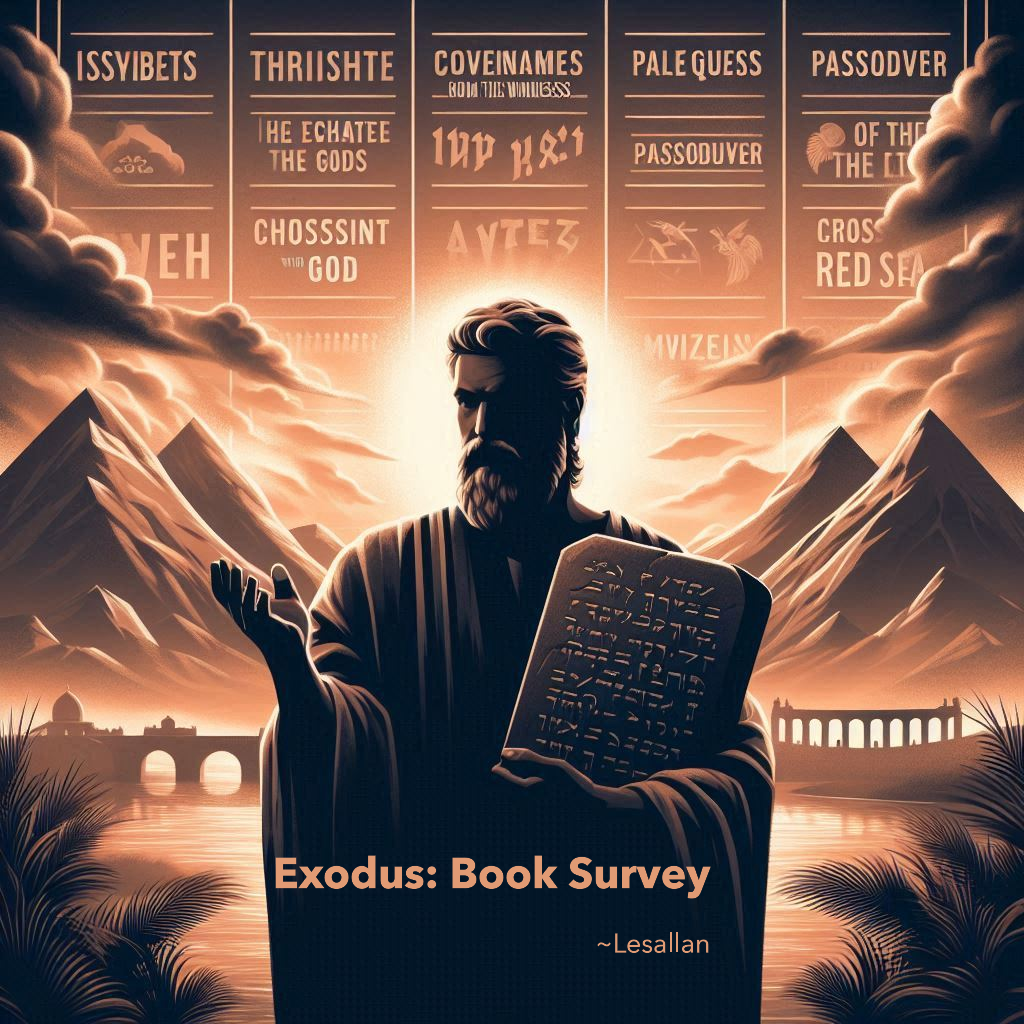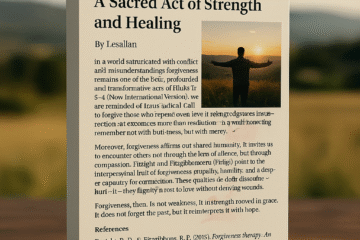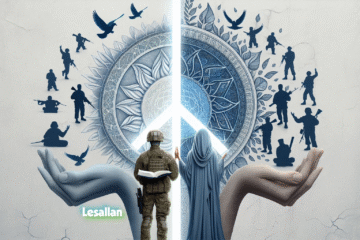Lesallan – August 25, 2024

Exodus: Book Survey
Version: ESV
General Materials
The Book of Exodus in the ESV version is historical, serving as a critical record of the formative events in the history of the Israelites. It meticulously chronicles the dramatic exodus of the Israelites from Egypt, their subsequent journey through the wilderness, and the profound establishment of the covenant with God at Mount Sinai. This historical account emphasizes pivotal occurrences that have shaped the identity and faith of the Israelite people. Notable events, such as the impactful plagues that led to their eventual release from slavery, the institution of the sacred Passover, the awe-inspiring crossing of the Red Sea, and the profound bestowal of the Ten Commandments, are intricately woven into the fabric of this historical narrative. This emphasis on historical events undoubtedly underscores the foundational significance of these moments in shaping the faith and cultural heritage of the Israelite people.
The book sheds light on the lives and importance of prominent individuals such as Moses, Aaron, and Pharaoh, whose decisions and actions influence the storyline. Exodus also conveys fundamental theological and moral principles, encompassing God’s salvation, covenantal relationships, and moral guidelines for living a virtuous life. These principles, as conveyed in the Book of Exodus, serve as the foundational pillars of the Israelite community’s faith and behavior, underlining the book’s profound significance.
Major Structural Relationships
Israel’s Deliverance from Egypt (Exodus 1-18, ESV).
Observation
This section provides a detailed account of the Israelites’ enslavement in Egypt, God’s call to Moses, the series of plagues, and the eventual deliverance of the Israelites as they crossed the Red Sea. The narrative begins with the oppression of the Israelites by the Egyptians in Chapters 1-2. It then proceeds to describe God’s call to Moses to lead the Israelites out of Egypt in Chapters 3-4. The subsequent chapters detail the ten plagues sent by God to persuade Pharaoh to free the Israelites (Chapters 5-12). Finally, the section concludes with the awe-inspiring exodus from Egypt and the miraculous crossing of the Red Sea, as the Israelites, in a dramatic escape, outpace Pharaoh’s pursuing army (Chapters 13-18).
What is the significance of the plagues in this structural relationship?
The plagues displayed God’s supremacy over Egypt and its deities, highlighting His status as the one true God. Additionally, they were instrumental in weakening Pharaoh’s opposition and forcing him to free the Israelites.
How does the Red Sea crossing contribute to the theme of deliverance?
The crossing of the Red Sea stands as a crucial event, symbolizing the deliverance, salvation, and protection by God. It signifies the conclusion of the Israelites’ enslavement and the commencement of their journey towards the Promised Land.
Covenant at Sinai (Exodus 19-24, ESV)
Observation
In this section, we delve into the profound account of the establishment of the covenant between God and the Israelites at Mount Sinai, a pivotal moment in religious history that culminates in the presentation of the Ten Commandments. The narrative unfolds with the arrival of the Israelites at Mount Sinai (Exodus 19, ESV), leading to the divine establishment of the covenant and the transmission of the Ten Commandments (Exodus 20-23, ESV). Subsequently, the covenant is solemnized through sacrificial offerings and the symbolic act of blood sprinkling (Exodus 24, ESV). This foundational event serves as a cornerstone in the understanding of religious and moral principles encapsulated within the Ten Commandments and sets the stage for the covenantal relationship between God and the Israelites.
What is the purpose of the Ten Commandments in this structural relationship?
The Ten Commandments function as the fundamental ethical and moral framework for the Israelites, delineating their duties to God and to one another. They play a critical role in the covenantal bond between God and His people.
How does the ratification of the covenant emphasize its importance?
During the ratification ceremony, ritualistic sacrifices and blood sprinkling symbolize the covenant’s solemn and obligatory essence. This act represents the Israelites’ dedication to God’s laws and recognition as His selected people.
Construction of the Tabernacle (Exodus 25-40, ESV)
Observation
In the book of Exodus, there is a detailed account of the construction and consecration of the Tabernacle, as well as the creation of the golden calf by the Israelites. The instructions for building the Tabernacle and its furnishings are provided in Chapters 25-31, outlining specific guidelines and materials to be used. This is followed by the infamous Golden Calf Incident, which depicts the Israelites’ rebellion against God and their creation of the idol while Moses was on Mount Sinai receiving the Ten Commandments (Chapter 32). The narrative then transitions to the actual construction of the Tabernacle in accordance with God’s instructions, which is detailed in Chapters 35-40. These chapters provide a comprehensive overview of the craftsmanship, materials, and dedication involved in creating the sacred space where God’s presence would dwell among the Israelites.
What is the significance of the Tabernacle in this structural relationship?
The Tabernacle, a sacred structure described in the Bible, holds deep symbolism in the Judeo-Christian tradition. It represents God’s dwelling place among His people, signifying His unending presence and guidance in their lives. This portable sanctuary served as the focal point for communal worship and provided a tangible reminder of the covenant relationship between God and His people. The intricate details of the Tabernacle, from its design to its rituals, reflect the divine care and diligence in establishing a sacred and reverent space for communication and communion with the divine.
How does the golden calf incident contrast with the construction of the Tabernacle?
The incident of the golden calf serves as a poignant reminder of the Israelites’ propensity to stray from their allegiance to God and the perilous consequences of succumbing to idol worship. It illustrates the challenges of maintaining faith and adherence to divine commandments in the face of temptation and uncertainty. Conversely, the construction of the Tabernacle represents a powerful symbol of steadfast dedication and profound reverence for God. It emphasizes the crucial importance of wholehearted devotion to the one true God, highlighting the concept of exclusive worship and the sanctity of spiritual connection. This juxtaposition of the golden calf incident and the erection of the Tabernacle underscores the eternal struggle between faithfulness and temptation, offering timeless lessons about the enduring nature of devotion and the consequences of straying from it.
Outline
I. Israel’s Enslavement and Moses’ Early Life (Exodus 1-2, ESV)
A. Israel’s Oppression in Egypt (1:1-22)
B. Birth and Early Life of Moses (2:1-25)
II. God’s Call to Moses and the Plagues (Exodus 3-12, ESV)
A. The Burning Bush and God’s Call (3:1-4:17)
B. Moses Returns to Egypt (4:18-31)
C. Confrontation with Pharaoh and the Plagues (5:1-11:10)
D. The Passover and the Exodus (12:1-51)
III. Journey to Mount Sinai (Exodus 13-18, ESV)
A. Consecration of the Firstborn and Departure from Egypt (13:1-22)
B. Crossing the Red Sea (14:1-31)
C. Song of Moses and Miriam (15:1-21)
D. Journey through the Wilderness (15:22-18:27)
IV. Covenant at Mount Sinai (Exodus 19-24, ESV)
A. Arrival at Mount Sinai (19:1-25)
B. The Ten Commandments (20:1-21)
C. Laws and Ordinances (20:22-23:33)
D. Ratification of the Covenant (24:1-18)
V. Instructions for the Tabernacle (Exodus 25-31, ESV)
A. Offerings for the Tabernacle (25:1-9)
B. Instructions for the Ark, Table, Lampstand, and Tabernacle (25:10-27:21)
C. Instructions for the Priests’ Garments and Consecration (28:1-29:46)
D. Additional Instructions for the Tabernacle (30:1-31:18)
VI. The Golden Calf and Covenant Renewal (Exodus 32-34, ESV)
A. The Golden Calf Incident (32:1-35)
B. Moses’ Intercession and God’s Response (33:1-23)
C. Renewal of the Covenant (34:1-35)
VII. Construction of the Tabernacle (Exodus 35-40, ESV)
A. Contributions for the Tabernacle (35:1-29)
B. Construction of the Tabernacle and its Furnishings (35:30-39:43)
C. Erection and Consecration of the Tabernacle (40:1-38)
Reportorial Questions
Who?
Who are the main characters in the Book of Exodus (ESV)?
The prominent figures in the narrative are Moses, Aaron, Pharaoh, and the Israelites.
What?
What is the central event in the Book of Exodus (ESV)?
The central event is the deliverance of the Israelites from slavery in Egypt and their journey to Mount Sinai.
When?
When did the events of Exodus (ESV) take place?
The events are traditionally dated to around the 13th century BCE, during the period of the New Kingdom of Egypt.
Where?
Where do the major events of Exodus (ESV) occur?
The major events occur in Egypt, the Red Sea, and Mount Sinai.
Why?
Why did God deliver the Israelites from Egypt?
God delivered the Israelites to fulfill His covenant with Abraham, Isaac, and Jacob, and to establish them as His chosen people.
How?
How did God demonstrate His power in the Book of Exodus (ESV)?
God demonstrated His power through the ten plagues, the parting of the Red Sea, and the giving of the Ten Commandments.
Key Verses
Exodus 3:14 (ESV): “God said to Moses, ‘I AM WHO I AM.’ And he said, ‘Say this to
the people of Israel: I AM has sent me to you.'”
Exodus 12:13 (ESV): “The blood shall be a sign for you, on the houses where you are. And when I see the blood, I will pass over you, and no plague will befall you to destroy you, when I strike the land of Egypt.”
Exodus 20:2-3 (ESV): “I am the Lord your God, who brought you out of the land of Egypt, out of the house of slavery. You shall have no other gods before me.”
Other Major Impressions
- The Book of Exodus highlights God’s faithfulness to His promises and His people.
- The establishment of the covenant at Mount Sinai emphasizes the importance of the relationship between God and the Israelites.
- God’s guidance through Moses and the provision of the Law demonstrates His care and direction for His people.



1 Comment
Techno rozen · August 25, 2024 at 6:37 pm
Techno rozen I truly appreciate your technique of writing a blog. I added it to my bookmark site list and will
Comments are closed.